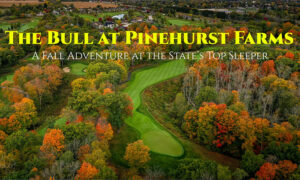In the late 90’s, business was booming as Destination Kohler took off in popularity following the acclaimed opening of Pete Dye’s masterpiece, the lake-hugging, major-hosting, spare-no-expense Straits Course. The appeal to build more golf courses couldn’t have been more lucrative, and land just to the west was eyed for a second course at Whistling Straits, yet again under the watch of Pete Dye.

This inland property had little chance to match the grandeur of its older sibling, though, especially in the absence of direct lakefront. Crafting a layout living up to the reputation of the Straits Course, without being a total letdown, was an immense challenge that required a different type of approach. For Whistling Straits’ second course, Dye approached this challenging project in a way that reminds me of a movie sequel.
Sequels often conform to a predictable pattern, following a similar plotline and style as the original movie but falling short of its cohesiveness and ingenuity. To compensate for this, the action is dialed up, the plot becomes more outrageous and the script is over-the-top. Take for example Home Alone 2: Lost in New York. This follow-up act to a cherished original classic chronicles Kevin McAllister’s new batch of troubles which become more extreme, his adventures more epic, his criminal enemies somehow more bumbling and the booby traps they fall prey to even more elaborate. As someone who adored the original film, I thought Home Alone 2 was rip-roaring fun. Which is the point – a sequel may not be as critically acclaimed as its predecessor, but audiences that love the original will still be thoroughly entertained by the wilder ride of the sequel.
In the same vein of a movie sequel, Pete Dye took every defining characteristic of the Straits Course (except, of course, the lake) and supersized it. The dunes were built taller, the bunkers dug deeper, more hazards were brought into play and the design principles were more eccentric. The result, now known as the Irish Course, was an inconsistent yet unforgettable property, the likes of which had never been seen in golf architecture.

A couple stretches on the Irish Course feel very much like Straits, most notably the first half of the back nine, with corridors surrounded by dunes and sweeping views of Lake Michigan. Another section of the layout plays through the property’s forested and hillier interior, with more of a Blackwolf Run feel. Finally, the remainder of the course is a varied collection of thrill rides filled with intimidating carries, extreme topography and an insatiable demand for heroic shots.
 The risk-reward par 5 5th winds through all sorts of trouble
The risk-reward par 5 5th winds through all sorts of trouble
Throughout my recent round at the Irish Course, I was constantly on the lookout for its famous herd of Scottish blackface sheep that roam the property to provide one of the most genuine over-the-pond experiences you’ll find stateside. Alas, they were locked in their pen adjacent to the 17th tee that day, but maybe in my next visit I’ll get to experience them firsthand like WiscoGolfAddict writers Paul Seifert and Troy Giljohann did last season.

The Irish Course wouldn’t make much sense as a standalone track, but paired up with its big brother by the lake it is an adventurous, scenic and engaging experience that adds outstanding variety to a 36-hole day. In my Kohler trip this fall, we played the Irish and Straits courses back-to-back and I found this to be a fantastic combo, with the Irish course providing the ideal warmup loop for Kohler’s crown jewel later that afternoon. I also appreciated the ability to ride in a cart in the first round, which made the mandatory walk on Straits later that day less taxing.
Related: Whistling Straits Golf Course Destination Kohler
COURSE OVERVIEW
Whistling Straits (Irish)
Haven, WI
Par 72, 7201/6750/6366/5992/5109 Yards
Course/Slope Rating: 75.6/146, 73.5/141, 72.0/137, 70.3/133. 65.6/122
Architect: Pete Dye (2000)
Notable Acclaim: Golf Digest Best in State #9 and Best U.S. Public #56; Golfweek Best Public in State #7 and Best U.S. Modern #186; Golf.com Best in State #15; WiscoGolfAddict.com Best in State #18 and Best Public in State #11
Notable Tournaments Hosted: 2005 Palmer Cup
COURSE HIGHLIGHTS
The Irish Course features a demanding start on holes 1-4, a more playable middle on 5-14, and a brute of a finish from 15-18. If one can survive the opening stretch, a good round could be in store.
This opening sequence features three stout par fours with the short par 3 third sprinkled in. The first plays towards the lake and parallel to the opener on the Straits course, but vast dunes block the view and provide a sense of solitude. And unlike the 1st at Straits, #1 at Irish challenges players with a starkly elevated green guarded by sand short and left. Be sure to take enough club on the approach, as anything left short could roll 30+ yards back down the fairway.
 The 1st at the Irish Course (from Paul Seifert’s 2022 “Wisconsin Captured” shoot)
The 1st at the Irish Course (from Paul Seifert’s 2022 “Wisconsin Captured” shoot)
The 2nd through 4th all set up for right-to-left ball flight, starting with the shorter par 4 2nd which bends around a lake. The short third provides a brief respite, followed by the brutal long par 4 4th. This stretch feasted on my raging slice, and I found myself +6 through 4, in fear of a very long round.
 The 4th at the Irish Course
The 4th at the Irish Course
Fortunately, the course lets up ever so slightly after the fourth, with some shots more accommodating to a fade, much to my delight.
The double dogleg fifth is reachable in two but requires a tee shot over a gaping sand pit with forest further right. The second shot must also avoid a bevy of trouble, with a waste area cutting into the layup zone and plenty more sand adjacent to the green.
One interesting tidbit about the Irish Course (and other tracks at Kohler, for that matter) are the hole handicaps. Even though they are certainly not easy, the par fives all carry higher handicaps. The fifth, for example, is the 14 handicap hole despite featuring an extensive buffet of trouble that could victimize a higher handicap player. Handicapping seems to be more art than science, and I’d love to see the process that goes into it.
 The 5th at the Irish Course
The 5th at the Irish Course
The shorter par 3 sixth plays adjacent to Whistling Straits’ entrance road, but you wouldn’t know it as the view from there is concealed by towering dunes lining the passageway. Like the third, this is an opportunity to make up ground on the scorecard, but any loose approach is more than likely to find a sea of sand surrounding the green.
 The 6th at the Irish Course
The 6th at the Irish Course
The shorter par 4 seventh is my favorite hole on the Irish Course, a beautiful dogleg right that makes wonderful use of the natural surrounds. Drives must steer clear of a large bunker right to set up a short iron approach. The green complex is one of the most gorgeous on site, an elevated surface against a forest backdrop. The right side of the green is disguised as a bailout zone but is actually a steep left-to-right slope that will direct balls to the edge or off the green. My fade naturally landed me in that area, from where I had to grind out a very tough two-putt par.
 The 7th at the Irish Course
The 7th at the Irish Course
The 8th and 9th continue the journey through Whistling Straits’ inland topography, including multiple encounters with the property’s winding creek. On the par 5 8th, the ideal drive will reach a plateau towards the end of the fairway, short of a downslope to the creek. From there, an uphill approach awaits to another green surrounded on most sides by Pete Dye’s notoriously tough bunkers.
 The 8th at the Irish Course
The 8th at the Irish Course
The par 4 9th varies dramatically in distance depending on the tee selected, and from the green tees it was a very manageable short distance. This is one of the most generous tee shots on site, with a gaping fairway sloping heavily from right-to-left. From the right side of the fairway, I faced a tricky wedge shot with the ball well above my feet to a narrow green fronted by the creek.
 The 9th at the Irish Course
The 9th at the Irish Course
The 10th through the 13th forms the highlight stretch on the Irish Course, running through the dunes in parallel to the Straits’ famed back nine. It is here that panoramic views of the lake come into view, particularly from the tops of the dunes. These four holes feel like everything Whistling Straits is known for, and are a fantastic complement to the similar style found on the Straits Course.
Related: Wild Rock: Wisconsin’s Most Underrated Public Golf Course
 The back 9 at the Irish Course (from Paul Seifert’s 2022 “Wisconsin Captured” shoot)
The back 9 at the Irish Course (from Paul Seifert’s 2022 “Wisconsin Captured” shoot)
The 10th is a mid-length par 4 playing starkly uphill to a narrow green. Accuracy is essential on the approach as a steep runoff into fescue exists on the left side. After pulling my second shot left, though, I got the break of the round as my ball settled atop the tall grass in a decent lie. From there, my uphill chip shot checked up to within gimmie range for a lucky yet easy par.
 The 10th at the Irish Course
The 10th at the Irish Course
The par 3 11th may be the signature hole on the Irish Course, a downhill mid-iron shot to a green nestled within towering dunes. From the tee, a clear view of the distant Lake Michigan captivates the senses, with parts of the Straits Course visible, as well. Of course, one shouldn’t spend too much time taking in the scenery as this demanding shot must avoid an array of sand around the green. I must have been distracted by the views as I found the front-right bunker and eventually carded a double bogey.
 The 11th at the Irish Course
The 11th at the Irish Course
The 12th continues the journey to the north, a straightaway par 4 cut right out of Dye’s artificial dunescape. The tee shot proved to be generous, as my slice bounded off a dune to the right and back into the fairway. The uphill approach carries a severe penalty for missing left. The pin position we faced was downright nasty, tucked tightly into the left corner of the green.
 The 12th at the Irish Course
The 12th at the Irish Course
The blind par 3 is one of the most controversial hole designs in the game. Not having a visible aiming point can be irritating, but to have an unknown, and potentially exceptional, fate of a well-struck shot is a feeling that can’t be replicated on a more conventional par 3.
The 5th at Lahinch, known as the “Dell Hole,” is the classic example that many architects have attempted to emulate over centuries. At the Irish Course, Dye offers his take on the blind par 3 at the 13th, aptly named “Blind Man’s Bluff.” Playing steeply downhill into the midst of several outsized dunes, the challenge of the tee shot is softened by short length, a massive green and one of the tallest pins I’ve ever seen that is ever-so-visible from the tee.
 The 13th at the Irish Course
The 13th at the Irish Course
The 14th is an adventurous par 5 with excellent risk/reward options – one of my favorite par 5’s at all of Destination Kohler. The tee shot must navigate past a ~200 yard bunker, one of the longest traps I’ve ever seen, to get into optimal position. My tee shot barely avoided the bunker, but from a baseball stance on its lip I was left with little choice but to bunt it down the fairway.
A creek cutting diagonally across the layup zone presents a series of options for better-placed drives – play short of the creek but accept a challenging uphill third shot, attempt to carry the creek to the left to set up a clear wedge in, or bring out the big guns and aim directly for an elevated green fronted by a series of deep bunkers. The green is set against a skyscraper dune, adding to the intimidation of the latter route.
 The 14th at the Irish Course
The 14th at the Irish Course
After a par at the 14th and standing on the 15th tee at just +8, I felt like I had weathered the storm and could post a respectable score. Unfortunately, I got punched in the face one last time by the Irish Course’s brutal finish.
The 15th and 16th are back-to-back lengthy par 4’s that demand great tee shots. Both holes are fraught with trouble, but the 15th was particularly intimidating with a forced carry over a marsh that made the fairway (which is actually quite wide) look like a speck of dust in a sea of trouble. After losing a ball to the waste area to the right, I was thrilled to escape with a 5.
 The 15th at the Irish Course
The 15th at the Irish Course
The 16th features a semi-blind tee shot with trouble once again lining the right side. In typical fashion, I blocked another one into the fescue right, but for a change I was actually able to find my ball in a decent lie and advance it near the green. A devilish pot bunker covers the center-left spot just short of the green, making a long iron approach even more challenging.
 The 16th at the Irish Course
The 16th at the Irish Course
The 17th is a shorter par 4 with a large pond stalking golfers all the way down the left side. With most of the course weaving in and out of dunes, bunkers and forest, this water-centric spot felt out of place.
Perhaps my opinion of the hole was shaped by my fate, which first involved a pulled tee shot finding a narrow bunker that borders the pond all the way up the left side. From there, I faced a full 8-iron sand shot, all carry over water with no margin for error and no reasonable bailout area. My slightly chunked shot easily found the drink, and I eventually carded a 7 even though I felt like my mistakes were not egregious.
 The 17th at the Irish Course
The 17th at the Irish Course
Having been beaten to a pulp on the 17th, I was eager to finish my round as quick as possible, but I still had to navigate the demanding par 5 18th. The closing hole features another intimidating tee shot with water left, followed by one final crossing over the creek which is well-positioned about 100 yards short of an elevated green. If in good position off the tee, it’s probably best just to rip your second shot as close to the green as possible, rather than layup short of the creek for a long uphill third.
CLOSING THOUGHTS
I had very mixed feelings coming out of my round at the Irish Course. Some holes absolutely blew me away, like the 7th, 11th and 14th. A few others irked me with their lack of playability like the 4th, 15th and 17th. The rest was a wild ride with a ton of variety, demanding a full arsenal of shots and strategy in order to score well. Dye will keep you on your toes from start to finish at the Irish Course.
It all started to make more sense when I played the Straits Course later that afternoon, though. The variety of the Irish Course paired extremely well with the more singular-themed Straits and resulted in a spectacular 36-hole experience.
The Irish Course holds its own, appearing in most best-in-state rankings and living up to the quality you’ll find at other Kohler courses. You’ll find it well within my Top 50 Course Rankings when I update the list at season’s end. Regardless of what you think of the Irish Course itself, though, it’s still Whistling Straits. You still get the same pre- and post-round experience centered around one of the most epic clubhouse settings in American golf.
 Even if you’re “only” playing the Irish Course, you’ll still get the full Whistling Straits pre- and post-round experience
Even if you’re “only” playing the Irish Course, you’ll still get the full Whistling Straits pre- and post-round experience
In many ways, the Irish Course marked the end of an era at Kohler, as this was Dye’s final installment at the resort, one where he dialed up all of his wacky ideas to the fullest extent. While the more recently built Baths par 3 course is a shadowy reflection of Whistling Straits, the bold and penal architecture Dye implanted at Kohler now represents a bygone era in American golf. As Dye wrapped up his work at Kohler at the turn of the century, architecture elsewhere in the country was starting to shift into a second golden age, with design principles not as focused on penal golf or heroic shotmaking. Dye’s style had seen its day, and another layout of his mold would have done little to add to Kohler’s appeal.
Nonetheless, what Pete Dye achieved at Kohler should be celebrated, not shunned, even if he got a little wild and over-the-top with his designs. Variety is the spice of life, and nowhere is this truer than in golf architecture in Wisconsin. I could not be more excited to see Destination Kohler continue to evolve and diversify its golf offerings.
Reports of a new King/Collins layout next to Blackwolf Run have architecture nerds buzzing with excitement, and I can’t wait to see what this up-and-coming duo, best known for their work at Sweeten’s Cove and Landmand, can do in the great state of Wisconsin.
Irish and Straits made for an unforgettable combo play, but what’s your ideal 36-hole day at Destination Kohler? We’d love to hear your opinions in the poll below and in the Comments section!



























